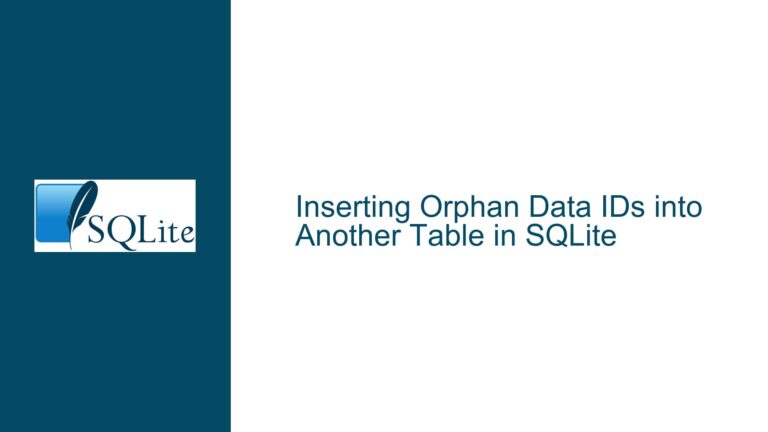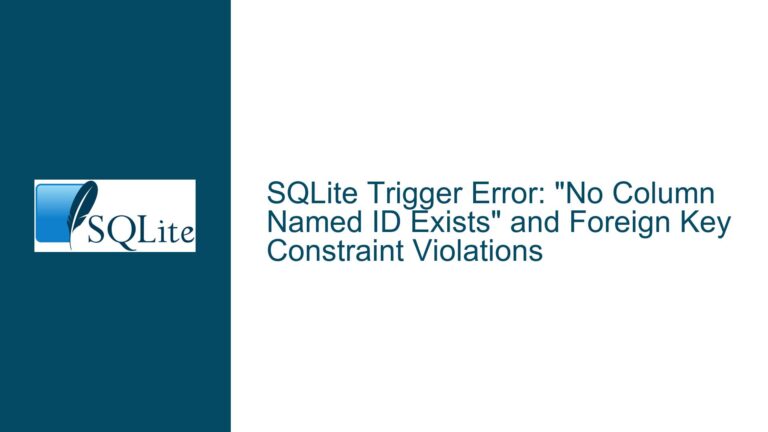Optimizing Versioned Updates and Global Change Counters in SQLite
Implementing Versioned Updates with a Global Change Counter
When working with SQLite in a multi-user environment, ensuring data consistency while tracking changes globally can be challenging. The core issue revolves around two main requirements: implementing versioned updates to prevent overwrites and maintaining a global change counter to track modifications across the database. This post will delve into the intricacies of these requirements, explore potential pitfalls, and provide detailed solutions to achieve robust and efficient implementations.
Versioned Updates and Global Change Counter Mechanics
The primary goal is to allow multiple users to modify data concurrently while ensuring that updates only occur if the data version matches the expected value. This prevents overwrites and maintains data integrity. Additionally, a global change counter is needed to track the total number of changes made across the database. The initial approach involves using a combination of UPDATE statements and a transaction to ensure atomicity. However, there are nuances and optimizations to consider.
The versioned update mechanism relies on a version column in the target table. When a user attempts to modify a record, they must specify the current version of the record. The UPDATE statement includes a WHERE clause that checks if the version matches the expected value. If the version has changed (indicating another user has modified the record), the update will affect zero rows, signaling a conflict.
The global change counter is maintained in a separate table (global_counter). After performing the versioned update, the global counter is incremented by the number of rows affected by the update. This ensures that the global counter accurately reflects the total number of changes made to the database.
Potential Issues with the Initial Implementation
While the initial implementation is functional, there are several potential issues and inefficiencies to consider. First, the use of changes() in the UPDATE statement for the global counter may not be optimal. The changes() function returns the number of rows modified by the most recent INSERT, UPDATE, or DELETE statement. However, it does not distinguish between different types of modifications, which could lead to incorrect increments if multiple operations are performed within the same transaction.
Second, the transaction scope may introduce unnecessary overhead. If the versioned update affects zero rows, the global counter is still incremented, which could lead to inaccurate tracking. Additionally, the use of BEGIN TRANSACTION and COMMIT may not be necessary if the application can handle the logic externally, such as by checking the result of the versioned update before committing.
Third, the initial approach does not account for scenarios where the global counter needs to be updated conditionally. For example, if the versioned update fails, the global counter should not be incremented. However, the current implementation increments the global counter regardless of the outcome of the versioned update.
Optimizing Versioned Updates and Global Change Tracking
To address these issues, we can refine the implementation by leveraging SQLite’s capabilities and best practices. The first optimization involves using sqlite3_changes64() in application code to determine whether the versioned update was successful. This function returns the number of rows modified by the most recent UPDATE statement, allowing the application to decide whether to commit the transaction or abort it.
The second optimization involves restructuring the global counter update logic. Instead of unconditionally incrementing the global counter, we can use a conditional update that only increments the counter if the versioned update affected at least one row. This ensures that the global counter accurately reflects the number of successful modifications.
The third optimization involves minimizing transaction overhead. If the application can handle the logic externally, we can avoid using explicit transactions and rely on the application to manage the commit or rollback based on the result of the versioned update. This reduces the complexity of the SQL statements and improves performance.
Detailed Troubleshooting Steps and Solutions
Step 1: Refactoring the Versioned Update Logic
The first step is to refactor the versioned update logic to ensure it only modifies the target row if the version matches the expected value. The UPDATE statement should include a WHERE clause that checks both the ID and the version columns. If the version does not match, the update will affect zero rows, indicating a conflict.
UPDATE my_table SET my_data = 'New Data', version = version + 1 WHERE ID = 3115 AND version = 41;
This statement ensures that the update only occurs if the record with ID = 3115 has a version value of 41. If another user has modified the record and incremented the version, the update will fail, and the application can handle the conflict appropriately.
Step 2: Implementing Conditional Global Counter Updates
The second step is to implement conditional updates for the global counter. Instead of unconditionally incrementing the global counter, we can use a conditional update that only increments the counter if the versioned update affected at least one row. This can be achieved using the changes() function in combination with a WHERE clause.
UPDATE global_counter SET value = value + 1 WHERE changes() > 0;
This statement ensures that the global counter is only incremented if the most recent UPDATE statement affected at least one row. If the versioned update failed (i.e., affected zero rows), the global counter remains unchanged.
Step 3: Leveraging Application Logic for Transaction Management
The third step is to leverage application logic for transaction management. Instead of using explicit BEGIN TRANSACTION and COMMIT statements in SQL, the application can handle the transaction logic based on the result of the versioned update. This reduces the complexity of the SQL statements and improves performance.
In application code, after executing the versioned update, the application can check the number of rows affected using sqlite3_changes64(). If the update affected at least one row, the application can commit the transaction. If the update affected zero rows, the application can roll back the transaction or handle the conflict appropriately.
int rows_affected = sqlite3_changes64(db);
if (rows_affected > 0) {
sqlite3_exec(db, "COMMIT;", NULL, NULL, NULL);
} else {
sqlite3_exec(db, "ROLLBACK;", NULL, NULL, NULL);
}
This approach ensures that the global counter is only incremented if the versioned update was successful, and it minimizes the overhead associated with explicit transactions.
Step 4: Testing and Validation
The final step is to thoroughly test and validate the implementation. This involves simulating concurrent updates to ensure that the versioned update mechanism prevents overwrites and that the global counter accurately reflects the number of successful modifications.
To test the versioned update mechanism, create multiple threads or processes that attempt to modify the same record concurrently. Each thread should specify the current version of the record when performing the update. Verify that only one thread can successfully update the record and that subsequent updates fail due to version conflicts.
To test the global counter, perform a series of updates and verify that the global counter is incremented only when the versioned update is successful. Ensure that the global counter remains unchanged when the versioned update fails.
Conclusion
Implementing versioned updates and a global change counter in SQLite requires careful consideration of concurrency, transaction management, and performance. By refactoring the versioned update logic, implementing conditional global counter updates, leveraging application logic for transaction management, and thoroughly testing the implementation, you can achieve a robust and efficient solution. This approach ensures data consistency, prevents overwrites, and accurately tracks changes across the database.






